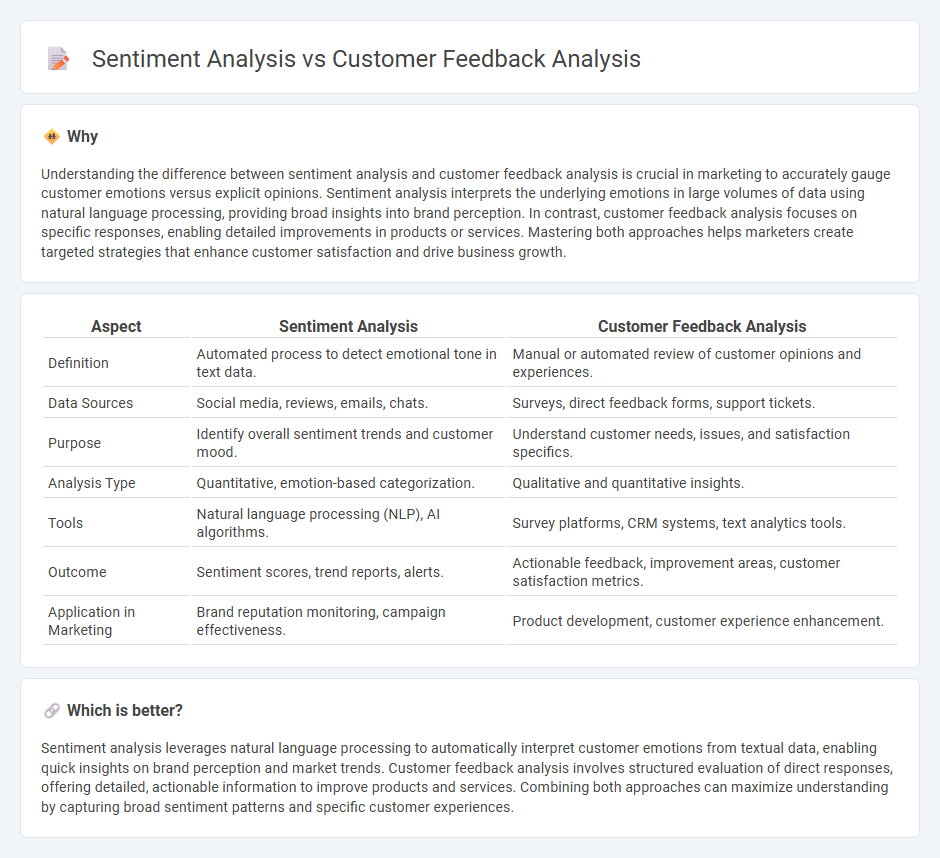
Sentiment analysis utilizes natural language processing and machine learning to automatically identify emotions and opinions within customer interactions, providing quantifiable insights into overall brand perception. Customer feedback analysis involves systematic collection and evaluation of direct user comments and survey responses to uncover specific pain points and satisfaction drivers. Explore deeper to understand how these approaches complement each other in enhancing marketing strategies.
Why it is important
Understanding the difference between sentiment analysis and customer feedback analysis is crucial in marketing to accurately gauge customer emotions versus explicit opinions. Sentiment analysis interprets the underlying emotions in large volumes of data using natural language processing, providing broad insights into brand perception. In contrast, customer feedback analysis focuses on specific responses, enabling detailed improvements in products or services. Mastering both approaches helps marketers create targeted strategies that enhance customer satisfaction and drive business growth.
Comparison Table
| Aspect | Sentiment Analysis | Customer Feedback Analysis |
|---|---|---|
| Definition | Automated process to detect emotional tone in text data. | Manual or automated review of customer opinions and experiences. |
| Data Sources | Social media, reviews, emails, chats. | Surveys, direct feedback forms, support tickets. |
| Purpose | Identify overall sentiment trends and customer mood. | Understand customer needs, issues, and satisfaction specifics. |
| Analysis Type | Quantitative, emotion-based categorization. | Qualitative and quantitative insights. |
| Tools | Natural language processing (NLP), AI algorithms. | Survey platforms, CRM systems, text analytics tools. |
| Outcome | Sentiment scores, trend reports, alerts. | Actionable feedback, improvement areas, customer satisfaction metrics. |
| Application in Marketing | Brand reputation monitoring, campaign effectiveness. | Product development, customer experience enhancement. |
Which is better?
Sentiment analysis leverages natural language processing to automatically interpret customer emotions from textual data, enabling quick insights on brand perception and market trends. Customer feedback analysis involves structured evaluation of direct responses, offering detailed, actionable information to improve products and services. Combining both approaches can maximize understanding by capturing broad sentiment patterns and specific customer experiences.
Connection
Sentiment analysis enhances customer feedback analysis by automatically categorizing emotions expressed in reviews, surveys, and social media comments, enabling brands to understand consumer attitudes and satisfaction levels. This integration helps marketers identify trends, detect issues, and tailor strategies based on real-time insights from large volumes of unstructured data. Leveraging tools like natural language processing (NLP) and machine learning improves the accuracy and efficiency of interpreting customer opinions, driving data-driven decision-making.
Key Terms
Customer Feedback Analysis:
Customer Feedback Analysis involves systematically collecting and interpreting customer opinions, preferences, and experiences to improve products and services. It leverages text mining, natural language processing (NLP), and machine learning to extract actionable insights from surveys, reviews, and social media comments. Explore deeper techniques and benefits of Customer Feedback Analysis to enhance customer satisfaction and drive business growth.
Net Promoter Score (NPS)
Customer feedback analysis involves evaluating qualitative and quantitative data from surveys, reviews, and social media to identify key themes and issues, while sentiment analysis uses natural language processing to determine the emotional tone behind textual data. Net Promoter Score (NPS) specifically gauges customer loyalty by categorizing respondents as promoters, passives, or detractors based on their likelihood to recommend a product or service. Explore how integrating sentiment analysis with NPS can provide deeper insights into customer satisfaction and drive strategic improvements.
Voice of the Customer (VoC)
Customer feedback analysis encompasses the comprehensive examination of raw data from customer inputs, while sentiment analysis specifically evaluates the emotions and attitudes expressed in that data to determine positive, negative, or neutral sentiments. Focusing on Voice of the Customer (VoC) initiatives, integrating both methodologies enables businesses to not only quantify customer satisfaction but also uncover deep insights into customer emotions and preferences, driving targeted improvements. Explore how combining customer feedback analysis and sentiment analysis can elevate your VoC strategy and enhance customer experience.
Source and External Links
Customer Feedback Analysis: A Mini-Guide (with Examples) - Customer feedback analysis evaluates and interprets customer input using methods like sentiment analysis, text analytics, speech analytics, machine learning, Voice of Customer programs, and Net Promoter Score to extract actionable insights for business improvements.
How To Analyse Customer Feedback: A Real-Time Approach - Analyzing feedback in real time involves using sentiment analysis and text analytics to uncover emotional tone and key themes from customers' comments, helping businesses quickly respond to needs and trends.
Feedback Analysis: Analyzing Quantitative and Qualitative ... - Effective customer feedback analysis combines quantitative data (numerical patterns) and qualitative data (textual insights) collected through methods like in-app surveys to generate actionable results that improve customer experience.
 dowidth.com
dowidth.com